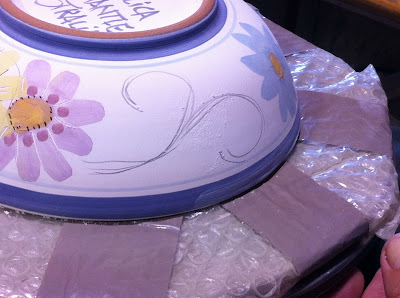Oh dear, a cliché already, using a song title (Carly Simon's) for a post title. I mentioned before that I am doing a residency at Central TAFE - aka Central Institute of Technology, Perth in the ceramics department so I will talk a little more of that. I applied to Central about eighteen months ago when I only had a small but purpose built studio in the back garden. Then I was lucky enough to rent a second work space for hand building and printing in Fremantle, close to home but up a stairs, albeit a very handsome stairs in the historical Old Customs House Building in Phillimore Street. At Central I've been making large platters and purging the need to do just that, to explore engobes and textural glazes and now, unexpectedly, after making about ten platters, finding myself wanting to get back to the wheel, play with porcelain, make fine, thin vessels - what for? To glaze, to decorate, to light from inside with candles to make best use of the translucency of porcelain, to get glowy thin melty glassy rims, to put flowers in, or small fruit, to hang glazes on the white canvas of Southern Ice porcelain - did I say I had the answers yet? I still assert that throwing with Southern Ice feels like I imagine throwing with Philadelphia Cream Cheese would feel.
I'd show you, but I keep forgetting to take photos because time is running out and I am getting quite a lot done. But this lure of the potter's wheel got me thinking, and trawling and I found some good videos to show you that kind of illustrate the contentment and zen-ness of working with clay.
I went back to bed this very cold morning after sending the lads off to school, got under the king sized electric duvet (or 'doona' to Aussies), snuggled up with Poppy - my cocker spaniel and we watched pottery vids on Vimeo on the iPad such as
Anne Mette Hjortshøj in Denmark, I have shared that one before, and
 |
| Rocking Bowl by Karin Eriksson |
Karin Eriksson of
Manos, in Stockholm, Sweden and
Phil Rogers in the UK. I think new pottery students should see these vids, to be inspired and excited and embraced into the world of throwing.
Now back to real life, supermarkets and work. I hope your day treats you well, especially you AC, hope 'the power' comes back on so your (magic) power comes back! Now get off your computer and make something.
Oh and did I mention yet that you lovely readers should hop on over to
Mud Colony regularly, at least every week, to see what a growing number potters who blog have to say about their week and work. Maybe you could join in with your blog?
 |
| Phil Rogers throwing a Yunomi |
























.JPG)











